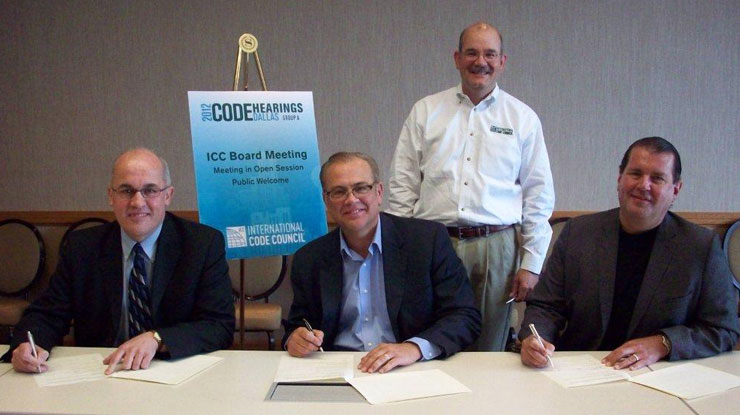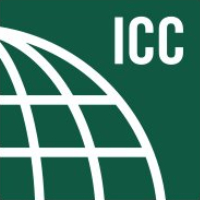
ICC, CDC and NEHA Unite to Enhance Public Safety
![]() Health and Safety Leaders Unite to Coordinate Design, Installation and Operational Codes for Even Greater Pool Safety
Health and Safety Leaders Unite to Coordinate Design, Installation and Operational Codes for Even Greater Pool Safety
Representatives from the International Code Council (ICC), Centers for Disease Control and Prevention (CDC) and the National Environmental Health Association (NEHA) have entered into a historic Memorandum of Understanding (MOU) intended to bring enhanced public health, safety and uniformity to design, installation, inspection and operation of aquatic facilities. The MOU reinforces ongoing cooperation and opens avenues for increasing the effectiveness of swimming safety through formal partnership. CDC, NEHA and ICC will share their respective strengths, knowledge and resources to support swimming pool and spa initiatives that advance their common goal to promote public health and safety.
“The implementation of the Virginia Graeme Baker Act has highlighted just how critical the role of both building and health officials are in the construction and operation of safe pools, spas, and waterparks,” said ICC CEO Rick Weiland. “We are committed to working collaboratively toward our shared goal of safe pool facilities, and pleased to collaborate in this important effort with the Centers for Disease Control and Prevention and the National Environmental Health Association.”
The 2012 International Swimming Pool and Spa Code (ISPSC) was developed by ICC in collaboration with the Association of Pool and Spa Professionals (APSP). It is available for adoption by jurisdictions nationwide. The ISPSC is the first comprehensive model pool and spa code, addressing minimum safety provisions for the construction of public and residential pools, spas, hot tubs and waterparks. Another critical benefit of the ISPSC is coordination with the entire family of I-Codes, which are adopted throughout the United States.
Building on the design and construction safety provisions in the ISPSC, the three organizations will support additional efforts the CDC is coordinating to develop the Model Aquatic Health Code (MAHC). The MAHC will focus on minimum health and safety in areas such as operator training and education, response to injury, body fluid containment, and drowning incidents, containment, ventilation, water chemistry, circulation, turnover rate, and disinfection of public swimming pool and spa facilities. The MAHC is a tool for local and state agencies interested in adopting or revising public health laws related to the prevention of illness and injury associated with recreational water. This effort is being led by CDC staff, health officials and many members of NEHA.
“CDC, ICC and NEHA all work to protect the public from various threats to their safety and health. By joining forces and combining our expertise to advance safety considerations for all who enjoy swimming pools, the public at large benefits in significant ways. NEHA is truly pleased to be a part of this cooperative initiative. The association also looks forward to contributing to all that these three organizations can accomplish together,” said Nelson Fabian, NEHA Executive Director and CEO.
“If we work together to support state and local jurisdictions that plan to review or revise their aquatic health laws using these two complementary codes, we can help to protect people and ensure they will continue to be safe and healthy while enjoying one of their favorite forms of exercise,” said Robert Blake, Chief of the Environmental Health Services Branch, part of the National Centers for Environmental Health at the CDC.
CDC works 24/7 keeping America safe from health, safety and security threats, both foreign and domestic. Whether diseases start at home or abroad, are chronic or acute, curable or preventable, human error or deliberate attack, CDC fights it and supports communities and citizens to prevent it. CDC is the nation’s health protection agency—saving lives, protecting people from health threats, and saving money through prevention.
NEHA stands as a strong professional society with over 4,500 members in the public and private sectors as well as in universities and uniformed services. Clearly NEHA’s mission, “to advance the environmental health and protection professional for the purpose of providing a healthful environment for all” is as relevant today as it was when the organization was founded in 1937. Advancement has been defined by NEHA in terms of both education and motivation. The basis for the association’s activities is the belief that the professional who is educated and motivated is the professional who will make the greatest contribution to the healthful environmental goals, which we all seek.
The International Code Council is a member-focused association dedicated to helping the building safety community and construction industry provide safe and sustainable construction through the development of codes and standards used in the design, build and compliance process. Most U.S. communities and many global markets choose the International Codes.








